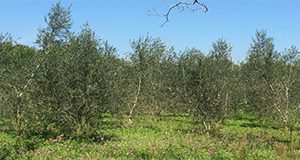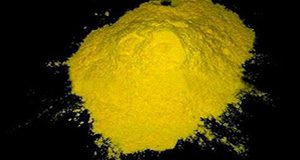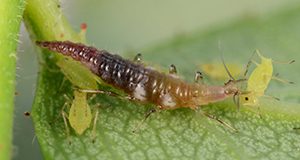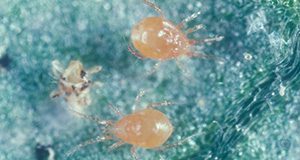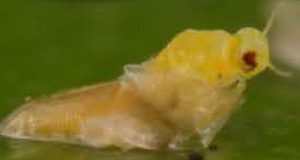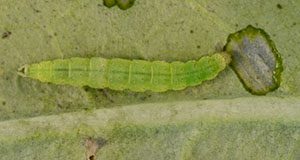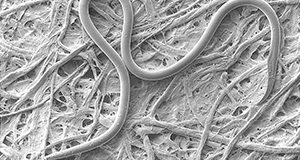To remain in optimal health and produce optimal yield, olive trees need excellent nutrition, the right irrigation, and good care to help them stay healthy so that they can withstand injury from pests and diseases. This 10-page fact sheet written by Morgan Byron, Eleanor Phillips, and Jennifer L. Gillett-Kaufman and published by the UF/IFAS Entomology and Nematology Department touches on some aspects of olive tree health that will help improve your trees' natural resistance to pests and pathogens. At the end of the guide is a monthly care and observation schedule to help you recognize when you should begin scouting for key pests and when important grove management decisions should be made.
http://edis.ifas.ufl.edu/in1251
Tag: Entomology and Nematology Department
Managing Plant Pests with Soaps
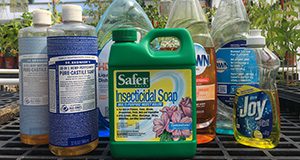
Home gardeners and professionals frequently discuss the use of soap products to control plant pests. Limited and conflicting information on this topic has resulted in confusion and misuse of products. It is important to recognize that all soaps are not equal in safety or efficacy in plant-pest management. This 5-page fact sheet written by Matthew A. Borden and Adam G. Dale and published by the UF/IFAS Entomology and Nematology Department describes some of the different types of soaps and recommendations for proper, legal, and safe use of these products to manage pests.
http://edis.ifas.ufl.edu/in1248
Diaprepes Root Weevil on Southern Highbush Blueberry in Florida
Citrus root weevil, Diaprepes abbreviatus (Linnaeus) is a destructive pest on citrus trees. It is now becoming a significant pest on blueberry in central Florida, at times causing major damage to blueberry bushes that are more than two years old. This 3-page fact sheet written by Douglas A. Phillips, Oscar E. Liburd, and Larry W. Duncan and published by the UF/IFAS Entomology and Nematology Department will educate blueberry growers on how to monitor, identify, and control citrus root weevil.
http://edis.ifas.ufl.edu/in1241
Oxytetracycline hydrochloride (OTC-HCl) application for control of palm phytoplasmas
Phytoplasma diseases of palms are a major threat to the Florida nursery and landscaping industries. Historically, lethal yellowing has killed millions of coconut palms throughout the Caribbean and has been causing decline of over 30 species of palm in Florida since it was introduced to the state in the first half of the 20th century. In 2006, lethal bronzing disease was discovered on the west coast of Florida near Tampa. Currently, the only two management options available for control of phytoplasmas is an aggressive sampling strategy followed by consistent tree removal and injections of oxytetracycline hydrochloride, or OTC. This 2-page fact sheet written by Brian W. Bahder and Ericka E. Helmick and published by the UF/IFAS Entomology and Nematology Department seeks to provide a source of information and instruction on the injection of OTC into palm trunks.
http://edis.ifas.ufl.edu/in1240
Natural Products for Managing Landscape and Garden Pests in Florida
Pest control professionals and homeowners throughout Florida and the southeastern US are seeking effective options that are safer for people and the environment than some conventional synthetic pesticides. There is also rising interest in organic gardening, which relies on natural pesticides. This 13-page fact sheet describes natural products for use in residential landscapes and gardens. Written by Matthew A. Borden, Eileen A. Buss, Sydney G. Park Brown, and Adam G. Dale, and published by the UF/IFAS Department of Entomology and Nematology, revised September 2018.
http://edis.ifas.ufl.edu/in197
Managing Insecticide and Miticide Resistance in Florida Landscapes
Resistance to insecticide or miticide is a worry for landscape managers. Around the world, chinch bugs, leafminers, and other insect and mite pests have become resistant to dozens of insecticides, but with diligent insecticide resistance management, we can still maintain long-term effective chemical control. With few new modes of action coming onto the market, landscape managers need to be good stewards of existing products. Ultimately, resistance management means reducing exposure of pests to any one pesticide. Fortunately, there are many ways to prevent resistance and still control pests of ornamental plants and lawns, and this 6-page fact sheet written by Nicole Benda and Adam Dale and published by the UF/IFAS Entomology and Nematology Department explains how.
http://edis.ifas.ufl.edu/in714
Susceptibility of Phytoseiulus persimilis and Neoseiulus californicus (Acari: Phytoseiidae) to Commonly Used Insecticides Approved for Managing Arthropod Pests in Florida Strawberries
The aim of this 9-page document is to inform Florida strawberry producers and Extension personnel on the compatibility of registered miticides and insecticides with commercially available predatory mites used as biological controls. Written by Braden Evans, Karol Krey, and Justin Renkema and published by the UF/IFAS Entomology and Nematology Department, August 2018.
http://edis.ifas.ufl.edu/in1216
Biology and Management of the Bermudagrass Mite, Eriophyes cynodoniensis
The bermudagrass mite, Eriophyes cynodoniensis (Sayed) (Arthropoda: Arachnida: Eriophyidae), also known as the couch grass mite, can be a serious pest of bermudagrass in multiple high-maintenance turf systems such as sod production, athletic fields, and golf courses. Mites cause leaf and bud galls, which can lead to severe aesthetic damage and plant decline or death in high-maintenance areas with low tolerance for plant damage. In this 7-page fact sheet written by Pablo Agustin Boeri, Nicole D. Benda, J. Bryan Unruh, and Adam Dale and published by the UF/IFAs Entomology and Nematology Department, review the biology, identification, and management of the bermudagrass mite, and get specific management recommendations based on evidence from UF/IFAS research.
https://edis.ifas.ufl.edu/in1217
Pest Identification Guide: Solanum (Pepper) Whitefly, Aleurotrachelus trachoides
Considered an emerging pest in Florida, the solanum whitefly has been in the state since at least the 1960s. It eats pepper, eggplant, and tomato, as well as other food crops, ornamental plants, and weeds. Learn to identify the little pest with this handy, 2-page guide written by Nicole A. Casuso and Hugh A. Smith and published by the UF/IFAS Entomology and Nematology Department.
http://edis.ifas.ufl.edu/in1201
Caterpillar Pests of Tiki Huts and Other Thatched Structures
Two species of caterpillars that eat dried sabal palm leaves have been causing problems with thatched structures. If you’ve got a chickee or are planning to get one, you can take steps to protect the thatch. Learn how to identify and manage the two caterpillar pests in this 4-page fact sheet written by Stephen H. Brown and Lyle J. Buss and published by the UF/IFAS Entomology and Nematology Department.
http://edis.ifas.ufl.edu/in1213
Pest Identification Guide: Rugose Spiraling Whitefly, Aleurodicus rugioperculatus
Rugose spiraling whitefly (Aleurodicus rugioperculatus) feeds on over 118 hosts including coconut palm, gumbo limbo, and other fruits and ornamentals. It is a major pest in Florida. Learn to identify these tiny flies with this handy, 2-page guide written by Nicole A. Casuso and Hugh A. Smith and published by the UF/IFAS Entomology and Nematology Department.
http://edis.ifas.ufl.edu/in1202
Pest Identification Guide: Ficus Whitefly Singhiella simplex
Ficuswhitefly (Singhiella simplex) is found on ficus species, especially weeping fig. It is a major pest in Florida. Learn to identify these tiny flies with this handy, 2-page guide written by Nicole A. Casuso and Hugh A. Smith and published by the UF/IFAS Entomology and Nematology Department.
http://edis.ifas.ufl.edu/in1203
Assessment-based Pest Management of German Cockroaches
Assessment-based pest management emphasizes the importance of evaluating the intensity of a pest problem before treating the problem. This 10-page fact sheet written by F.M. Oi, E. Weeks, J. Jonovich, and D. Miller and published by the UF/IFAS Entomology and Nematology Department explains the strategy and includes a decision flow chart to provide an easy-to-follow overview on how a German cockroach problem can be assessed and successfully managed with specific guidance for each of four levels described in the fact sheet. The levels described constitute an escalation protocol that may approximate the tiers in a LEED (Leadership in Energy and Environmental Design) pest-management plan and may meet the requirements of some “green” pest-management certification programs, depending on level.
http://edis.ifas.ufl.edu/in1190
Ant Control in the Apiary
Ants are one of a beekeeper’s most common pests, both in the apiary and in the honey house. Florida and the southeastern United States have a large and diverse ant fauna, with both native and exotic species. The vast majority of ant species have no impact on our bees or us. This 8-page fact sheet written by William H. Kern and published by the UF/IFAS Department of Entomology and Nematology describes the few pest species can cause serious problems and suggests ways to control the ants for healthier hives.
http://edis.ifas.ufl.edu/in1181
Managing Whiteflies on Landscape Ornamentals
Whiteflies are a common pest of many ornamental plants throughout Florida and the world. There are more than 1,500 species worldwide and over 75 reported in Florida. Although infestation does not always require treatment, it is important to be able to identify and monitor for these pests for effective integrated pest management. This 8-page fact sheet written by Eileen A. Buss, Catharine Mannion, Lance Osborne, and Adam Dale and published by the Entomology and Nematology Department describes whitefly species, their identification and biology, the damage they cause, and best management practices to control them and still maintain healthy populations of natural enemies and other beneficial insects.
http://edis.ifas.ufl.edu/mg254
Manejo de Insectos en Cruciferas (Cultivos de Coles) (Brocoli, Repollo, Coliflor, Col, Col Rizada, Mostaza, Rabano, Nabos)
Los vegetales conocidos como crucíferas son un grupo de cultivos amplio y cada vez más importante en Florida. Un número de insectos se alimenta exclusivamente de crucíferas y afecta todos los cultivos enlistados en el título.
This thirty-page fact sheet is the Spanish translation of IG150: Insect Management for Crucifers (Cole Crops). Written by S.E. Webb, A. Nino, y H.A. Smith and published by the Entomology and Nematology Department.
http://edis.ifas.ufl.edu/ig168
Fumigant and Non-Fumigant Nematicides Labeled for Agronomic Crops in Florida
Plant-parasitic nematodes can cause severe yield loss of agronomic crops in Florida. Chemical products for managing plant-parasitic nematodes are called nematicides. This three-page facts heet describes the nematicides registered for use in Florida. Written by Zane Grabau and published by the Department of Entomology and Nematology.
http://edis.ifas.ufl.edu/in1152
Integrated Pest Management (IPM) of the Tawny Crazy Ant, Nylanderia fulva (Mayr)
The tawny crazy ant infests buildings and greenhouses, attacks crops, domestic animals, and honeybee hives, displaces native ant species, and disrupts electrical equipment. This 8-page fact sheet describes how to identify the ant and monitor for infestations. It explains how to eliminate food sources and harborages and presents an integrated pest management plan and specific approaches to control this pest ant. (Note: the tawny crazy ant is a serious pest that multiplies quickly and can easily become an overwhelming problem. If you suspect you have tawny crazy ants, the best approach is to call a licensed pest-control professional for help). Revised by Faith Oi, Dawn Calibeo, John Paige III, and Michael Bentley and published by the UF Department of Entomology and Nematology.
http://edis.ifas.ufl.edu/in889
New Featured Creatures for October 2016
- A Bark Beetle Hypothenemus eruditus Westwood, 1836
http://edis.ifas.ufl.edu/in1147 - Fourlined Plant Bug Poecilocapsus lineatus (Fabricius)
http://edis.ifas.ufl.edu/in1151 - Insidious Flower Bug, Minute Pirate Bug Orius insidiosus Say
http://edis.ifas.ufl.edu/in1148 - Longtailed Mealybug Pseudococcus longispinus (Targioni Tozzetti)
http://edis.ifas.ufl.edu/in1149 - Tuliptree Scale Toumeyella liriodendra (Gmelin)
http://edis.ifas.ufl.edu/in1150
Zika Vector Control for the Urban Pest Management Industry

Zika is a mosquito-transmitted virus that has recently spread to the Americas. Zika virus (ZIKV) was discovered in 1946 in Africa where it was isolated from a Rhesus monkey in the Zika forest of Uganda. In 2007, a disease outbreak occurred on the Yap islands in Micronesia, and in 2013, an outbreak occurred in French Polynesia. In 2015, a large outbreak occurred in Brazil, and ZIKV has since spread through the Americas. As of April 18, 2016, 15 counties in the state of Florida had reported travel-associated Zika cases. This seven-page fact sheet provides an overview of ZIKV, including its incidence and distribution, transmission and symptoms, and the connection between zika virus and infant microcephaly. This article also explains the biology and identification of the mosquito that vectors the virus with a focus on how to manage the vector using inspection, larviciding, adulticiding, monitoring, and personal protective equipment. Written by Casey Parker, Roxanne Connelly, Dale Dubberly, Roberto Pereira, and Philip Koehler and published by the Entomology and Nematology Department.
http://edis.ifas.ufl.edu/in1131
